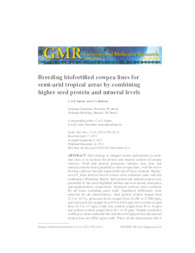Breeding biofortified cowpea lines for semi-arid tropical areas by combining higher seed protein and mineral levels.
Breeding biofortified cowpea lines for semi-arid tropical areas by combining higher seed protein and mineral levels.
Author(s): SANTOS, C. A. F.; BOITEUX, L. S.
Summary: One strategy to mitigate human malnutrition in semi-arid areas is to increase the protein and mineral content of cowpea cultivars. Total seed protein, potassium, calcium, iron, zinc, and sodium contents were quantified in elite cowpea lines, with the aim to develop cultivars that had improved levels of these nutrients. Eighty-seven F6 lines derived from 6 crosses were evaluated under rain-fed conditions in Petrolina, Brazil. Seed protein and mineral content were quantified by the micro-Kjeldhal method and in an atomic absorption spectrophotometer, respectively. Statistical analyses were estimated for all traits, including grain yield. Significant differences were observed for all characteristics. Seed protein content ranged from 22.5 to 34.1%, potassium levels ranged from 20,200 to 27,000 ppm, and calcium levels ranged from 410 to 6260 ppm. Iron content ranged from 36.5 to 137 ppm, while zinc content ranged from 36 to 58 ppm and sodium content ranged from 29.2 to 88 ppm. Simple correlation coefficient values indicated that selection for high protein and mineral content does not affect grain yield. These results demonstrate that it higher levels of protein and essential minerals.
Publication year: 2013
Types of publication: Journal article
Unit: Embrapa Semi-arid Region
Observation
Some of Embrapa's publications are published as ePub files. To read them, use or download one of the following free software options to your computer or mobile device. Android: Google Play Books; IOS: iBooks; Windows and Linux: Calibre.
Access other publications
Access the Agricultural Research Database (BDPA) to consult Embrapa's full library collection and records.
Visit Embrapa Bookstore to purchase books and other publications sold by Embrapa.

